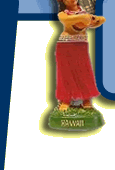




History of the Hawaiian Steel Guitar
Part I - The Great Beginningby Chris Kennison
Where did steel guitar come from? It had to start somewhere. Most players will agree it was originally invented in Hawaii. The story has many twists and turns, but I’ll try and give you some insight in this, and future articles. When we say “Hawaiian Steel Guitar” we mean the style of playing a guitar by sliding a steel bar of some kind up and down the strings while laying the guitar flat on your lap, or suspended flat in front of you somehow on legs, or a strap, or table. That’s the basic mechanics that describe the style—but of course many genres of music can be played on the steel guitar in all its forms.
The Hawaiian Islands are often called the ‘melting pot of the Pacific’ for good reason. For decades outside influences from around the world have been integrated into the current culture. Early European immigrants brought their music and instruments to the islands beginning in the 1700’s and added a new sound to the traditional music that existed. The two instruments most associated with Hawaii today are the Ukulele and the Steel Guitar.
When the ship the ‘Ravenscrag’ arrived in Honolulu on the afternoon of August 23, 1879, it was carrying 419 Portuguese immigrants from the island of Madeira to work in the sugar cane fields. It had been a long and hard journey of over 4 months and some 15,000 miles. In celebration of their arrival, Joao Fernandes borrowed his friend’s braguinha, jumped off the ship, and started playing folks songs from his native land on the wharf. The Hawaiians who came down to the dock were very impressed at the speed of this musician’s fingers as they danced across the fingerboard and they called the instrument “ukulele,” which translates into English as “jumping flea.” You see, that was the image conjured up by those flying fingers.
The origin of the steel guitar is more hotly debated, with many stories outlining how it was born. Most will not debate that it sprang from the regular 6 string guitar. Hawaiians had the guitar before the ukulele. Portuguese immigrated as early as 1794, and the guitar was in use in Hawaii in the early 1800’s. To play the regular guitar, Hawaiians created their own unique tunings and invented the Slack Key style we know today. Slack Key means to slacken the strings and tune to a full chord or variation of an open chord. There are many common Slack Key open tunings in use today, and many more that performers customize to meet their needs for the music. The open tuning is a key element, because these open tunings were usually full chords. This set the stage for evolving the slide playing technique known today as steel guitar.
Legend has it that around 1880, Joseph Kekuku, a Hawaiian schoolboy, discovered the sound while walking along a railroad track strumming his guitar. He picked up a bolt lying by the track and slid the metal along the strings of his guitar. Intrigued by the sound, he taught himself to play using the back of a knife blade. The steel sound imitated the characteristic vocal vibrato prevalent in Hawaiian singing. He shared his style with others and the sound became popular in Hawaii about 1880. The name “steel guitar” comes from the fact that it’s played with a steel bar, and usually played lying flat. It’s not to be confused with ‘slide guitar’ where a guitarist uses a glass bottle neck or metal hollow slide to make notes. However, many believe early Blues artist developed their slide styles after seeing and imitating early Hawaiian musicians touring in the early 1920’s.
The introduction of Hawaiian music to the mainland US was a major step in the evolution of the musical culture in Hawaii and the world. In 1915 the ukulele and steel guitar were introduced on the U.S. mainland. That was the year of the Panama-Pacific International Exposition in San Francisco, where Hawaii hosted a pavilion. The exposition celebrated the completion of the Panama Canal and lasted for 7 months. With exhibits from countries all over the world it attracted more then 17 million people, an amazing number considering the population in those days! The Territory of Hawaii viewed it as an important opportunity to promote its products, land, people and tourism, and the legislature appropriated over $100,000 for a Hawaiian Pavilion. The main attraction turned out to be the Hawaiian show featuring hulas and songs which ran many times a day. The music created a sensation! This was the first time that Hawaiian music had been promoted on the U.S. mainland and it soon swept the country. Not long after, steel guitar was everywhere.
Between 1915 and 1941 the U.S. Mainland and the rest of the world embraced the music of Hawaii. Early Tin Pan Alley and Hawaiian songwriters blended Jazz and Big Band era music with Hawaiian music and themes to create a virtual paradise on the radio for people longing for something better during the Great Depression. Hapa Haole (half white) songs with their English lyrics, Hawaiian themes and jazz flavorings fueled the early tourist industry in Hawaii. The music quickly spread around the world influencing many musicians and musical styles including Country Swing, Gospel, and Blues. Today’s use of the pedal steel guitar in Country music traces its roots directly to the Hawaiian invention. In those years, the great steel players began to evolve and change the instrument to fit all types of music. Steel was here to stay.
NEXT TIME: Hawaiian Steel Guitar History Part II - Transformation!
How did the acoustic Hawaiian Steel from 1880 transform itself into the three main steel instruments (the Resonator Guitar [aka ‘Dobro], Electric lap steel, and the modern Pedal Steel) we play to day?Aloha a hui hou,
Chris
Chris Kennison plays traditional Hawaiian Steel in Book 'em Danno and lives in Ft. Collins, Colorado. He also belongs to the Hawaiian Steel Guitar Association - where he listens, plays, and learns from the masters. He can also occasionally be found sitting behind a D-10 pedal steel in the long time Country band - ROUNDER in Ft. Collins.
Some fun reading for steel guitar fans:
- The Hawaiian Steel Guitar and Its Great Hawaiian Musicians by Lorene Ruymar - excellent history, stories, pictures.
- Lap Steel Guitar by Andy Volk - covers all types of lap steel, plus profiles of the great players.

